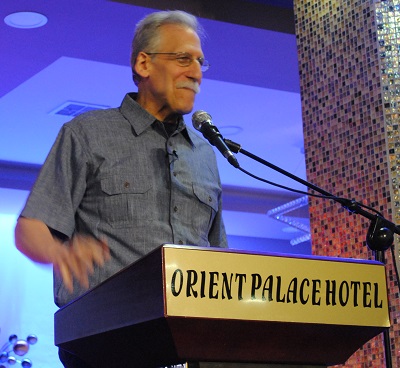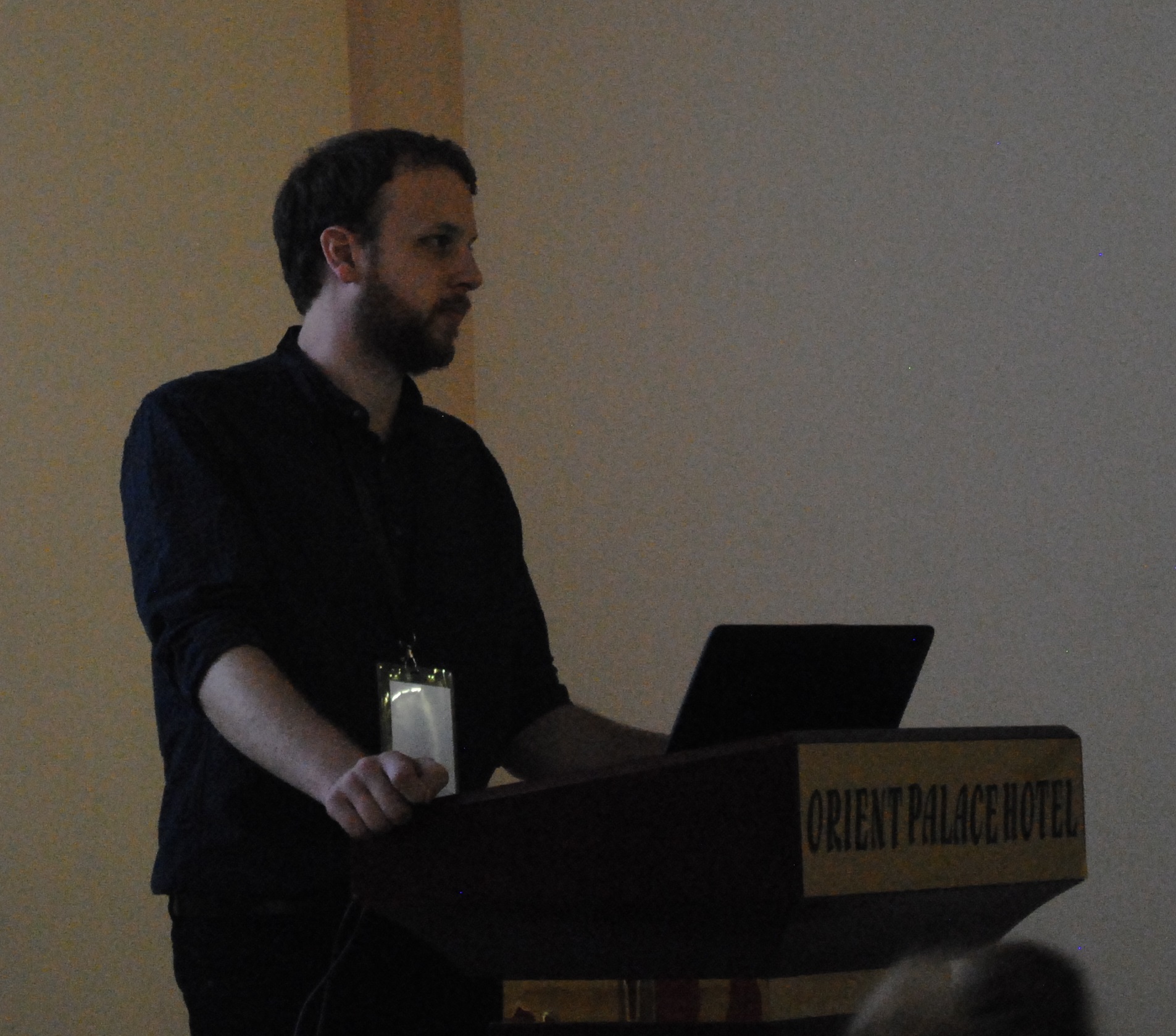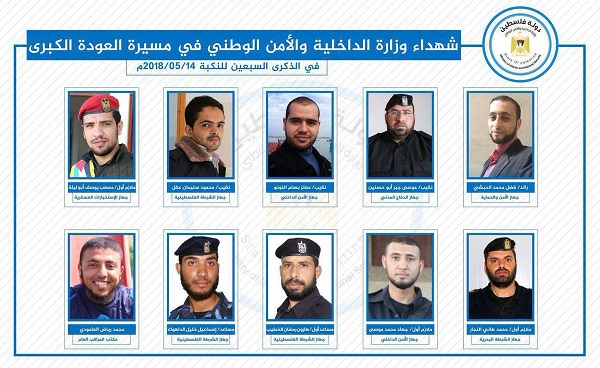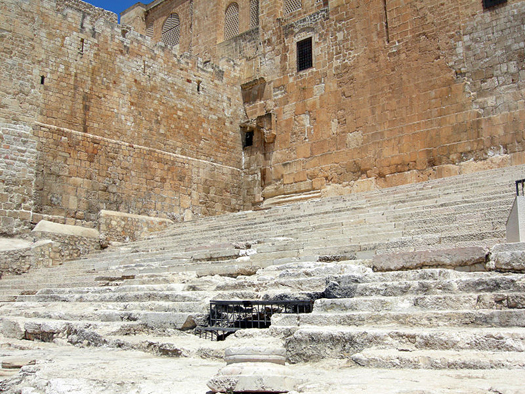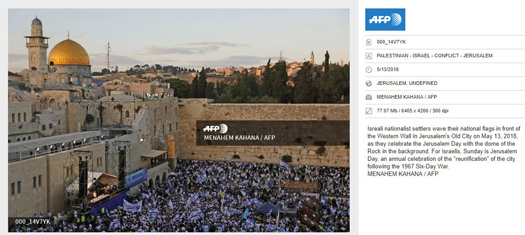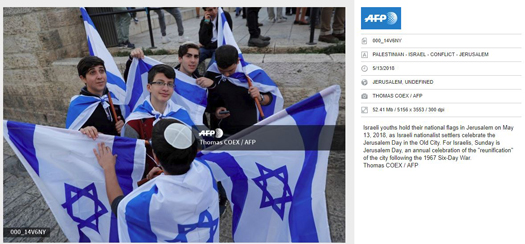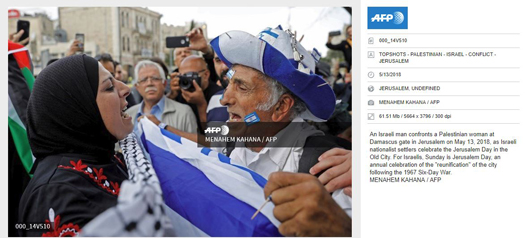Recent Entries:
Month: May 2018
May 30, 2018
Some Real Self-Criticism at CATC
< Activists attending the Christ at the Checkpoint Conference in the West Bank view anti-Trump graffiti on the security barrier near the checkpoint between Bethlehem and Jerusalem. Speakers at the conference, which began on Monday, May 28, 2018 and will last until Friday, June 1, 2018, have lamented the role American Evangelicals played in putting Donald Trump into the White House. They have been less vocal about the lack of democratic institutions in Palestinian society. (Photo: Dexter Van Zile) The central problem with Palestinian Christian witness about life in the Holy Land is that its criticism is almost invariably directed at Israel and its supporters in the West. Very little is said about the misdeeds of Palestinian elites even though the decisions they have made have contributed greatly to the continued existence of the conflict between Israel and the Palestinians. The people who are most responsible for Palestinian suffering – Palestinian leaders – are not subjected to the type of prophetic criticism that Christians are called to provide.
This problem is clearly on display at the Christ at the Checkpoint Conference taking place this week in Beit Jala. At this conference, organized by Bethlehem Bible College, there has been very little criticism of the misdeeds of the Palestinian Authority in the West Bank and Hamas in the Gaza Strip at the ongoing Christ at the Checkpoint Conference organized by the Bethlehem Bible College.
There is, however, a huge amount of criticism of Evangelicals in the U.S. for helping President Donald Trump get elected to the White House in the 2016 election. Trump’s election and his decision to move of the U.S. Embassy from Tel Aviv to Jerusalem is clearly a shock to CATC conference organizers and attendees. One conference organizer, Alex Awad (a Palestinian Christian who now lives in the United States) described Trump’s election as a dark cloud brought about by White Evangelicals who put him into office.
“They helped elect a president who dashed our hopes as Palestinians,” Awad said the first night of the CATC conference which began on Monday. “He brought us a nightmare.” Awad went onto encourage Evangelicals in the audience to increase their efforts to put pressure on Israel to end the occupation and to change American foreign policy in the Middle East.
The irony is palpable. Christians who are not free to speak their mind in Palestinian society and haven’t been able to vote in a presidential election since 2005 are effectively telling Christians in the U.S. how they should have voted in the 2016 election.
To a certain extent, the failure of Christians to speak truth to the powers that be in Palestinian society is understandable because neither the PA nor Hamas tolerate public criticism from anyone, Christian or Muslim, in the areas they control. To confirm just how dictatorial political life is in Palestinian society, in 2017 the PA just imposed laws regarding social media. These laws make criticizing the Palestinian Authority a criminal act.
One report indicates that these new laws “gives the public prosecutor’s office unlimited powers to surveil Palestinian citizens, intercept their online communications, and arrest them for airing their opinions and political views online.” People who are convicted of using the internet to undermine “social harmony” can be sentenced to 15 years hard labor.
Such tyranny in Palestinian society is a huge obstacle to peace in the Holy Land because it allows both the PA and Hamas to put Palestinian young people into harm’s way without being held accountable by their parents or by the young people themselves. Palestinian elites can effectively send young men into violent confrontations with the IDF without any real public debate over whether or not it’s a good idea to do so – all because the people who hold power in Palestinian society will not tolerate the humiliation of being criticized in public.
Polling data indicates that many Palestinians support a two-state solution, but because democratic institutions are non-existent in the West Bank and Gaza, rank-and-file Palestinians have no mechanism to make it happen. All they can do is worry about who will replace the ailing Mahmoud Abbas and hope that the process to find his successor does not descend into civil war. These are not subjects being discussed at the current Christ at the Checkpoint conference even though they are the most crucial issues facing the Palestinian people.
Ironically enough, one institution in Palestinian society where leaders are willing to subject themselves to public criticism is its Evangelical community.
(more…)May 30, 2018
Michael Brown Exposes Double-Standard at Christ at the Checkpoint
Michael Brown speaks at the Christ at the Checkpoint Conference on May 29, 2018. (Photo: Dexter Van Zile)Every two years, the ritual is repeated. The organizers of the Christ at the Checkpoint Conference, a so-called peacemaking conference held every even-numbered year at the Orient Palace Hotel in Beit Jala, invite a Messianic Jew to defend Israel before an audience of Evangelical Christians, some of whom have come to the West Bank to hear and relate stories of Jews behaving badly and then use these stories to feed an unwholesome bitterness toward Israel.
The invitation is given by conference organizers from the Bethlehem Bible College, an Evangelical college in Beit Jala, to demonstrate that they are willing to listen to people who disagree with them. It’s not as if the organizers really want to hear or acknowledge what he has to say, but instead hope to deploy the Messianic Jew as a prop to lend credibility to their anti-Zionist narrative.
It’s an obvious set-up, but the the Messianic Jew, who desperately wants to be taken seriously as a believer in Jesus and as a Jew who loves Israel, says yes. He knows full well other speakers at the conference will do everything they can to counteract his defense of Israel, but the invitee concludes that if he says agree to speak, no one will speak on Israel’s behalf at the conference.
During his talk, the Jewish believer in Jesus acknowledges that the Palestinians are suffering, laments this suffering and then offers an apologia of Israel’s efforts to defend itself, most notably the security barrier and the checkpoint. Everyone applauds his sincerity and for a few moments, expresses sympathy for the Israelis.
But by the time the conference is over, the Messianic Jew’s presence at the Christ at the Checkpoint has been forgotten, or worse, used to remind Evangelicals in attendance that Israel is the sovereign state of the people who have rejected Jesus. The message implicit in the talk is that if only more Jews in Israel accepted Jesus as their messiah, like that guy on stage, the conflict between the Israel and the Palestinians would have ended years ago.
But that’s not how it happened during this year’s Christ at the Checkpoint. Not by a long shot.
(more…)May 29, 2018
Why Does a NY Times Journalist Want to Suppress an Anti-Hamas Article?
A New York Times journalist thinks the Wall Street Journal shouldn’t have published an opinion piece criticizing Hamas’s anti-Israel propaganda campaign. The reporter, Declan Walsh, is one of the Times reporters who has covered the recent clashes along the Gaza Strip’s border with Israel.
The first to suggest the article should have been spiked was Gregg Carlstrom, a correspondent for The Economist:
Why do newspapers give Israeli mouthpieces space to accuse journalists (including their own!) of being naive, incompetent apologists for terror? https://t.co/PIYieXDmac
— Gregg Carlstrom (@glcarlstrom) May 21, 2018
Walsh concurred. “Fair question,” he responded on Twitter.
Fair question https://t.co/CUC4dZpFfT
— Declan Walsh (@declanwalsh) May 21, 2018
What arguments does the Wall Street Journal piece make that are so egregious, so beyond the pale, that they prompted these two journalists to wish editors had suppressed it? And what exactly did the author of the Op-Ed, an Israeli army spokesman, say about journalists being “naive, incompetent apologists for terror”?
In fact, the piece was almost entirely focused on Hamas, its goals, and its propaganda. It charged Hamas leaders with lying when describing the Gaza demonstrations they organized as a “peaceful protest,” and lamented that “much of the world simply fell for it.” And it said that “some in the media helped Hamas by publishing its lies rather than facts.”
And …that’s all.
The irony is striking. Carlstrom and Walsh are criticizing journalists — in this case Wall Street Journal opinion editors — because they seem to believe criticizing journalists should be taboo. How to make sense of the self-contradiction in their call for self-censorship?
In the case of the New York Times writer, Declan Walsh, it could be that the criticism in the Journal piece struck a bit too close to home. Walsh is one of the New York Times reporters who’ve counted Hamas gunmen that opened fire on Israelis, and Palestinians planting explosives, as supposed “protesters” killed by Israel.
So criticism of Wall Street Journal opinion editors is okay. But criticism of “some journalists” — maybe, for example, journalists who outrageously count gunmen as protesters? — is, conveniently out of bounds according to Carlson and Walsh.
You can read the piece the reporters wanted suppressed by clicking here.
May 28, 2018
Distorted History at Christ at the Checkpoint 2018
Jack Munayer speaks at the Christ at the Checkpoint, 2018. (Photo: Dexter Van Zile) May 28, 2018 marks the first day of the Christ at the Checkpoint Conference, a so-called peacemaking event organized by the Bethlehem Bible College, a non-denominational Evangelical institute of higher learning located in Beit Jala in the West Bank. Speakers from around the world purport to inform attendees about the Israel-Palestinian conflict and how Evangelicals, particularly those in the United States and Europe, can help bring the conflict to an end.
On the afternoon prior to the first night of the conference, which is held every two years, organizers host an orientation session where first-time attendees are instructed in the history of the conflict. This year’s session was offered by Jack Munayer, an Israeli citizen who like his father Salim, has been particularly harsh in his description of Israel and its supporters.
Munayer, who was introduced as an “expert” by Gary Burge, a former professor at Wheaton College in Illinois, offered a particularly one-sided depiction of the Arab-Israeli conflict. For example, he described the expulsion of Arabs from Lydda during the 1948 War as premeditated act of ethnic cleansing perpetrated by Israel without informing his audience of more than 100 listeners, most of them first-time attendees, that Arabs were expelled from the city after a previously agreed upon truce was violated by the inhabitants of the city. It was this violation that precipitated the expulsion that Munayer describes.
During the question and answer period, Munayer was asked how the Palestinians have come to grips with with the legacy of the Grand Mufti of Jerusalem, who assisted the Nazis in the Holocaust and also broadcast virulent Jew-hatred into Muslim countries in the Middle East during World War II, once telling his listeners in a radio address to “kill the Jews wherever you find them.”
Munayer’s response was telling.
(more…)May 22, 2018
Iran is Funding Hamas’s Violent ‘Protests’ at the Border, Media M.I.A.
The Islamic Republic of Iran is behind the recent Hamas-orchestrated violent demonstrations—dubbed the “March of Return”—at the Israel-Gaza border, according to Israeli authorities. Yet many major U.S. news outlets have failed to report Tehran’s role.
Israel’s domestic intelligence agency, the Shin Bet, stated:
““From the information we have, it appears Hamas is encouraging and sending protesters to the border fence in order to carry out violent acts and damage security infrastructure. In addition, it was found that Iran is providing funding to Hamas in order for it to carry out these violent activities along the Gaza Strip’s border fence.”
As CAMERA has detailed (see, for example “Palestinian Nazi Flags and Hamas Talking Points,” JNS, April 26, 2018) Hamas and other U.S.-designated terrorist groups have been organizing the demonstrations, interspersing armed operatives among civilians being used as human shields. Most of those killed in the demonstrations by the Israeli Defense Forces (IDF) have been linked to terror organizations.
Hamas is one of many terror groups funded by the Islamic Republic, which the U.S. State Department has listed as the leading state sponsor of terrorism. The group has long supported Hamas, Palestinian Islamic Jihad (PIJ), and others participating in the “March of Return.” Like Hamas, Iran’s ruling theocrats have called for Israel’s destruction and genocide of the Jewish people.
Iranian-backed groups have also recently offered 100,00 U.S. dollars to blow up the recently opened U.S. embassy in Jerusalem (“Iranian Group Offer $100,000 Reward for Bombing U.S. Jerusalem Embassy,” Newsweek, May 15, 2018).
Major U.S. news outlets, including The Washington Post, The Baltimore Sun, USA Today, and others, have ignored the Shin Bet’s statement about Iran’s role in the “march.” By contrast, The Times of Israel and The Jerusalem Post each filed reports detailing the comments by Israeli officials.
The press has largely failed to provide unbiased, balanced and accurate coverage of the Hamas-led demonstrations, which have been ongoing since late March 2018. Many journalists have omitted or minimized Hamas’s role and ignored readily available photographic and video evidence showing armed terrorists attempting to infiltrate and bomb Israel’s sovereign border. Both The New York Times and The Washington Post, among others, have continued to refer to “protesters” killed by the IDF long after Hamas itself has acknowledged that many of them were terrorists.
A state-sponsor of terrorism has been identified as supporting what the media has, in Orwellian fashion, termed “non-violent” and “organic protests.” And the press can’t be troubled to report it.
May 21, 2018
Are Gaza Gunmen “Protesters”? NY Times Refuses to Say
After repeatedly insisting that “Israeli soldiers killed 60 protesters” during clashes last Monday, May 14, the New York Times is refusing to clarify whether its count of supposed protesters includes the eight armed Hamas fighters who, according to the Israeli army, opened fire on on Israeli soldiers.
A Times article first published on May 15 reports that 60 Gazans were killed during the classes, attributing that number to Palestinian officials. It goes on to say that, according to the Israeli army, “eight of the dead … were armed Hamas militants in civilian clothes who tried to storm the fence in northern Gaza and attacked Israeli forces with grenades and pipe bombs before being killed in a shootout” while another three were killed “while laying an explosive device.” So far so good.
But if at least 11 of those killed were reportedly armed fighters engaged in hostilities, why do subsequent New York Times pieces claim that “60 protesters” were killed that day?
When CAMERA asked about this apparent misuse of language, the Times insisted that its reporting on the events is accurate. When asked to clarify whether that means its reporters concluded, contrary to Israel’s assertion, that none of the 60 killed were in fact shooting at Israelis or planting explosives, or if not whether it means the newspaper feels comfortable describing armed militants among the 60 dead as “protesters,” editors declined to comment.
It’s a straightforward question, and it should be forthrightly answered. The New York Times promises to treat readers it “as openly as possible.” Other journalistic codes of ethics consider accountability to be a core ethical guideline. The Society of Professional Journalists code, for example, says journalists should “clarify and explain news coverage and invite dialogue with the public over journalistic conduct.”
It’s not asking too much to request some transparency on a narrow and straightforward question about the paper’s reporting on the 60 “protesters.” And by refusing to clarify, the newspaper looks as though it has something to hide. Why?
May 25 Update: A New York Times editor has told CAMERA that that it is accurate and appropriate to describe Hamas gunmen that opened fire on Israeli soldiers as “protesters.”
May 15, 2018
Bahrain Says Israel Has a Right to Self-Defense, and the Media Shrugs
The foreign minister of the Arab nation of Bahrain, Sheikh Khalid al-Khaalifa declared on May 10, 2018 that Israel has a right to defend itself. The remarks, which came after an Iranian-Israeli confrontation in Syria, mark a sharp break with the past, in which Arab countries condemned the Jewish nation’s use of self-defense. Nonetheless, many major U.S. news outlets did not cover the story.
On Twitter, Al-Khalifa proclaimed:” “As long as Iran has breached the status quo in the region and invaded countries with its forces and missiles, any state in the region, including Israel, is entitled to defend itself by destroying sources of danger.”
Multiple U.S. news organizations failed to note al-Khalifa’s comments, including The Washington Post, The New York Times, USA Today, and The Baltimore Sun, among others. Several outlets, however, did note the historical significance of the comments, including The Times of Israel (“Bahrain backs Israeli strikes on Iranian targets in Syria”), The Jerusalem Post (“Bahrain and Israel: Quo Vadis?”), the Algemeiner (“Bahrain: Israel is ‘Entitled to Defend Itself’”)—even the Beirut Daily Star.
As CAMERA has detailed (“Where’s the Coverage? Bahrain Foils Terror Plot,” Jan. 11, 2016), Bahrain has frequently found itself attacked and subverted by the Islamic Republic of Iran, which has sought to manipulate the Gulf nation’s sizable Shi’ite Muslim population. Hezbollah, the Lebanese-based, Iranian-backed terror group, has been involved in several plots to overthrow the Bahraini government. Top regime apparatchiks in Tehran routinely assert that Bahrain belongs to Iran, as the Middle East Media Research Institute (MEMRI) has documented (see, for example “Editor Close to Khamenei Says Bahrain Belongs to Iran,” March 11, 2018).
Bahrain is but one of several Arab nations, including, most notably, the Kingdom of Saudi Arabia, which have lessened their antipathy towards Israel in the face of Iranian imperialism and aggression.
Yet, some pundits and reporters are prone to asserting that Israel is increasingly “isolated” or “losing global influence.” However, recent events—even when underreported—prove otherwise.
May 15, 2018
Reuters Backgrounder on Jerusalem Misleads on Holy Sites
Steps leading to the Temple Mount entrance on the southern side, one of several above ground remains of the Temple complexA Reuters feature yesterday meant to explain and unpack the complexities of Jerusalem misleads on the city’s holy sites (“The U.S. is opening an embassy in Jerusalem. Why is there a furor?“)
First, about the Temple Mount/Haram al-Sharif, the article states: “Muslims regard the site as the third holiest in Islam, after Mecca and Medina.” While noting that the site is the third holiest in Islam, the article fails to note that the very same site is the most sacred in Judaism. In the past, Reuters has commendably fixed this egregious oversight.
In addition, the same article errs that the Temple Mount “was home to the Jewish temples of antiquity but all that remains above ground is a restraining wall for the foundations built by Herod the Great.” In fact, there are several surviving above ground remains in addition to the western, southern, eastern and northern retaining walls. Extant features abutting the southern wall include a broad stairway leading up to the Temple Mount’s entrance and two gates, known as Huldah Gates, which provided access to the Temple Mount (Hershel Shanks: Jerusalem: An Archeological Biography, p. 143). Some of the interior part of the Herodian Double Gate (which is one of the Huldah Gates) is also still intact. In addition, an area called “Robinson’s Arch,” in the south-western corner of the Temple complex, still remains. In his book, Shanks provides details concerning numerous other remnants.
CAMERA has contacted Reuters editors to request a correction. Stay tuned for an update.
May 15, 2018
AFP Captions Call Jerusalem Parade Participants Settlers
Numerous Agence France-Presse photo captions generalized all participants in Sunday’s Jerusalem Flag Parade as “settlers,” despite the fact that the crowd hailed from across Israel, within the Green Line, as well as outside. A sampling of the misleading captions follows:
Isreali [sic] nationalist settlers wave their national flags in front of the Western Wall in Jerusalem’s Old City on May 13, 2018, as they celebrate the Jerusalem Day with the dome of the Rock in the background. For Israelis, Sunday is Jerusalem Day, an annual celebration of the “reunification” of the city following the 1967 Six-Day War. MENAHEM KAHANA/AFP
Israeli youths hold their national flags in Jerusalem on May 13, 2018, as Israeli nationalist settlers celebrate the Jerusalem Day in the Old City. For Israelis, Sunday is Jerusalem Day, an annual celebration of the “reunification” of the city following the 1967 Six-Day War. Thomas COEX/AFP
An Israeli man confronts a Palestinian woman at Damascus gate in Jerusalem on May 13, 2018, as Israeli nationalist settlers celebrate the Jerusalem Day in the Old City. For Israelis, Sunday is Jerusalem Day, an annual celebration of the “reunification” of the city following the 1967 Six-Day War. Menahem Kahana/AFPCAMERA yesterday contacted AFP to request a correction. The wire agency has yet to clarify.
May 13, 2018
CNN Arabic Calls Western Wall ‘Al Buraq’
May 16 Update: CAMERA Arabic Prompts CNN Arabic Correction on ‘Al Buraq’ Wall
Jack Ma visits the Western Wall May 2018 (Photo from Western Wall Heritage Foundation)Early this month, Alibaba CEO Jack Ma visited the Western Wall, donning a kippah and honoring the holy Jewish site, a remnant of the Jewish Temple compound. On what basis, then, did CNN Arabic refer to the site using its Muslim name, “Al Buraq wall”?
As CAMERA Arabic earlier noted, a CNN Arabic story seems to violate CNN practice by referring to the Western Wall, one of Judaism’s holiest sites, by a Muslim name, “Al Buraq Wall.” The May 2 article (“Founder of the ‘Ali Baba’ group to visit Israel and meet Netanyahu“), says of Ma’s visit to the Jewish holy site: “Activists on social networking photographed Ma, standing by the Wall of Al-Buraq in Jerusalem during his visit to Israel.”
Use of an Islamic name in context of a visit intended to honor the site’s special status in Judaism is clearly inappropriate and misleading. Furthermore, not only does CNN in English not use the term “Al-Buraq” wall to refer to the Western Wall, but CAMERA Arabic has confirmed that CNN Arabic has not used this misleading term in the past.
CAMERA has contacted CNN to request modification of the terminology. Stay tuned for an update.
Search:
Search this site:


